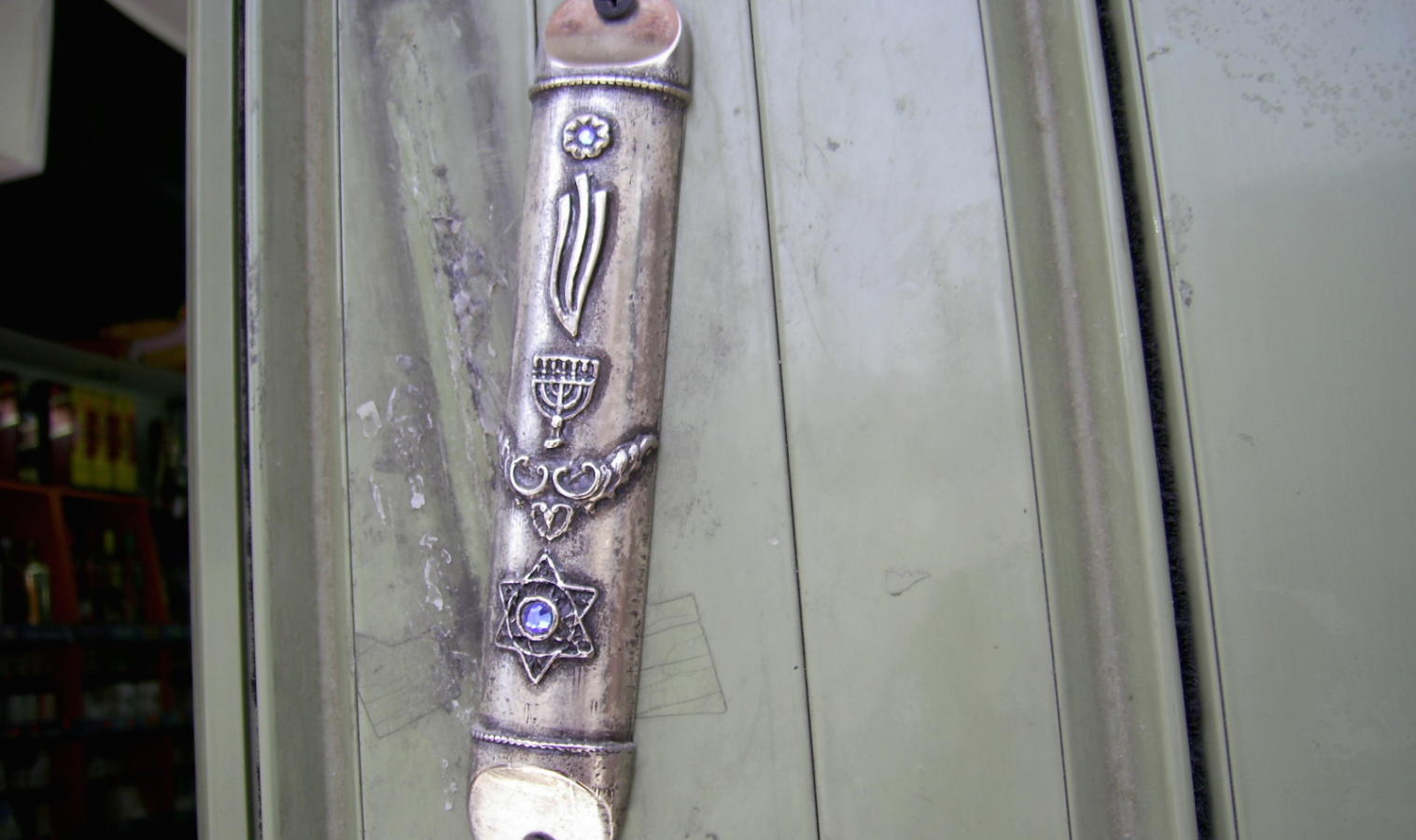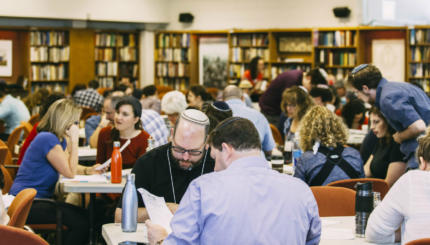Jewish life revolves around two institutions: the home and the community. Each is endowed with unique meaning, and between these two–the private and public spaces–education, ritual, and everyday life takes place
Home Sweet Home
The Jewish home is where core identity of young Jews is formed. And it is formed not through abstract ideas, but through concrete experiences of the five senses. The tastes, smells, sounds, and images of Jewish life are first experienced in the home–through observance of Shabbat and festivals, living a Jewish life every day, and making the home a meaningful Jewish space. Following the destruction of the Temple in Jerusalem in the year 70 C.E., the rabbis decided the home would be the mikdash m’at–“small sanctuary”–a holy place responsible for fostering the family’s spiritual life.
Ritual Objects
The most prevalent symbol of a Jewish home is the mezuzah affixed to the upper portion of the right side of the door. The mezuzah is a small parchment scroll protected by a decorative case. The scroll contains two passages from Deuteronomy, 6:4-9 and 11:13-21, which comprise the first two sections of the Shema prayer. The case can be made of wood, metal, glass, plastic, or ceramic. Traditional Jewish law requires every room except the lavatory to have a mezuzah, though many families only put one on their main entranceway.
An important concept in Jewish life is hiddur mitzvah, the beautification or enhancement of religious practice. In that spirit, Jewish homes are filled with ornamental ritual objects such as candlesticks, kiddush cups, hannukiyot (Hanukkah candelabras), and other items. Married couples may prominently hang their ketubah (wedding contract), which often is decorated beautifully. In modern times, a Jewish home also often includes art by Jewish or Israeli artists.

Help us keep Jewish knowledge accessible to millions of people around the world.
Your donation to My Jewish Learning fuels endless journeys of Jewish discovery. With your help, My Jewish Learning can continue to provide nonstop opportunities for learning, connection and growth.
Since learning sacred texts is a core Jewish value, the Jewish home usually contains a library, which at a minimum includes a prayerbook (for weekdays, Shabbat, and holidays) and a Tanakh (Hebrew Bible). Many libraries also include other classical and modern Jewish texts of law, theology, history, and culture
Jewish Community and its Institutions
Jewish families cannot live in isolation. To live a full Jewish life requires engagement with other Jews, a Jewish community. The community provides services and experiences that the home cannot, and in addition, fellowship and participation in community have inherent spiritual value in Judaism.
While Jews can pray individually, the presence of a minyan (a quorum of 10 or more men, or adults) is required for certain portions of the service. Thus, the synagogue emerged as the central institution of the community. Historically, the synagogue included a beit midrash (a place for study) and often, a guest room for travelers. Many synagogues contain a mikveh (ritual bath) used for people to immerse in and also for readying new dishes and cooking utensils for use in a kosher kitchen. Today, many synagogues house religious schools for community youth, and some have gyms or swimming pools for recreation.
As Jewish communities grew larger, some functions of the synagogue were transferred to separate institutions, including yeshivot or day schools, Jewish homes for the sick or elderly, and social service agencies for charity collection and distribution. Today, many of these activities and others are the function of centralized communal organizations called Federations. Federations support Jewish schools, community centers, family and counseling services, vocational services, residential services for disabled or elderly populations, and philanthropy for agencies that provide these same services to Jews in other lands and in Israel.
In addition to the Federations, myriad organizations provide programs and services focused on specific issues or specific populations. These include B’nai B’rith, Hadassah, ORT, National Council of Jewish Women, Jewish War Veterans and numerous others.
Other functions of the Jewish community include:
· Providing kosher food requires bakeries, butchers, and other establishments supervised by overseers familiar with the details of both food chemistry and the laws of kashrut.
· Burial of the dead requires cemetery land set aside for this purpose. In most American Jewish communities, a Jewish cemetery preceded the organization of the first synagogue. But, burial is not the only issue. The body must be washed, dressed and attended prior to burial. The hevrah kadisha–burial society–attends to these needs through Jewish funeral homes.
· With the invention of movable type, Jewish booksellers and Jewish bookstores became a feature of the community. Today, these stores sell Jewish ritual items as well.
The diversity of family life today demands that the community be prepared to not only provide those functions inherent to community, but also to fill in the gaps of Jewish home life. Jewish schools, summer camps, youth groups, and community centers all reinforce the home experiences, or in some cases, provide these experiences for the first time. The community is therefore the partner of the home in creating and perpetuating a vibrant Jewish life.
kosher
Pronounced: KOH-sher, Origin: Hebrew, adhering to kashrut, the traditional Jewish dietary laws.

Help us keep Jewish knowledge accessible to millions of people around the world.
Your donation to My Jewish Learning fuels endless journeys of Jewish discovery. With your help, My Jewish Learning can continue to provide nonstop opportunities for learning, connection and growth.
mezuzah
Pronounced: muh-ZOO-zuh (oo as in book), Origin: Hebrew, a small box placed on the right doorpost of Jewish homes. It contains a parchment scroll with verses from the Torah inscribed on it, including the Shema prayer (Deuteronomy 6:4-9, 11:13-21).

Help us keep Jewish knowledge accessible to millions of people around the world.
Your donation to My Jewish Learning fuels endless journeys of Jewish discovery. With your help, My Jewish Learning can continue to provide nonstop opportunities for learning, connection and growth.



